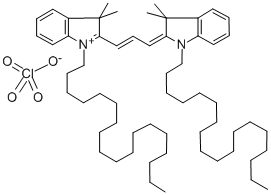All AbMole products are for research use only, cannot be used for human consumption.

DiI or DiIC18(3) is one of the most commonly used cell membrane fluorescent probes with a maximum excitation wavelength of 549 nm and emission wavelength of 565 nm. It shows orange-red fluorescence. Commonly used as a long-term tracer for neurons and other cells. Store at room temperature away from light.

J Control Release. 2025 Mar 05;381:113607.
Multifunctional nanoparticles for immune regulation and oxidative stress alleviation in myocarditis
DiI purchased from AbMole

Inorg Chem. 2023 Oct 9.
Green Synthesis of Carboxymethyl Chitosan-Based CuInS2 QDs with Luminescent Response toward Pb2+ Ion and Its Application in Bioimaging
DiI purchased from AbMole

J Nanobiotechnology. 2021 Nov 25;19(1):391.
Nanovesicles derived from bispecific CAR-T cells targeting the spike protein of SARS-CoV-2 for treating COVID-19
DiI purchased from AbMole
| Molecular Weight | 933.87 |
| Formula | C59H97ClN2O4 |
| CAS Number | 41085-99-8 |
| Solubility (25°C) | DMSO 5 mM Ethanol 5 mM |
| Storage | -20°C, protect from light, dry, sealed |
| Related Fluorescent Dye Products |
|---|
| PGSK diacetate (5/6-mixture)
PGSK diacetate (5/6-mixture) is a metal ion-sensitive fluorescent probe that can penetrate cell membranes. PGSK diacetate can react with a variety of metal ions, including Fe2+, Cd2+, Co2+, Ni2+, Zn2+, etc. PGSK diacetate chelates Fe2+, resulting in fluorescence quenching, which can be restored when a membrane-permeable chelator is added, thereby reflecting the changes in the intracellular chelatable iron pool. The excitation/emission maxima of PGSK diacetate are 507/532 nm, respectively. |
| Dextran-Rhodamine B
Dextran-Rhodamine B (RB-Dextran) is a fluorescent marker made by combining rhodamine B fluorescent dye and dextran polysaccharide through a specific chemical reaction. RB-Dextran is a red fluorescent modified dextran polysaccharide formed by chemically labeling rhodamine B onto dextran molecules, which can be used in cell tracing, biofluid dynamics research and other fields, and its fluorescent properties can be used to track the distribution and metabolism of dextran in organisms and other processes. |
| N-Succinimidyl 6-(2,4-Dinitroanilino)hexanoate
N-Succinimidyl 6-(2,4-Dinitroanilino)hexanoate, the DNP-X acid modified by succinimidyl ester, is an amine-reactive building block for developing a probe, which can be recognized by anti-DNP antibodies. |
| FITC-Arachidonic Acid
FITC-Arachidonic Acid is a fluorescent labelled compound for biomedical research. FITC-Arachidonic Acid combines the biological activity of arachidonic acid and the fluorescent properties of FITC, and is suitable for the study of cellular signalling, lipid metabolism and so on. |
| Arachidonic acid-biotin
Arachidonic acid-Biotin is a biotin-labeled Arachidonic acid that can be used to detect complexes of arachidonic acid with protein binding partners such as fatty acid binding proteins (FABPs). |
All AbMole products are for research use only, cannot be used for human consumption or veterinary use. We do not provide products or services to individuals. Please comply with the intended use and do not use AbMole products for any other purpose.


Products are for research use only. Not for human use. We do not sell to patients.
© Copyright 2010-2024 AbMole BioScience. All Rights Reserved.
